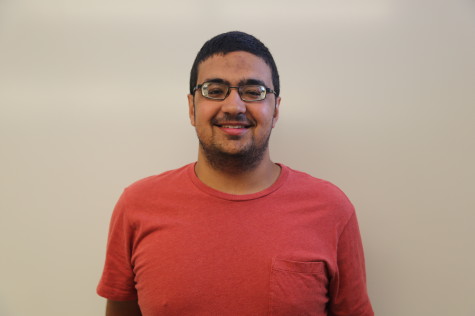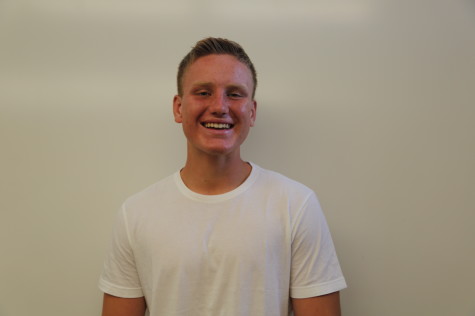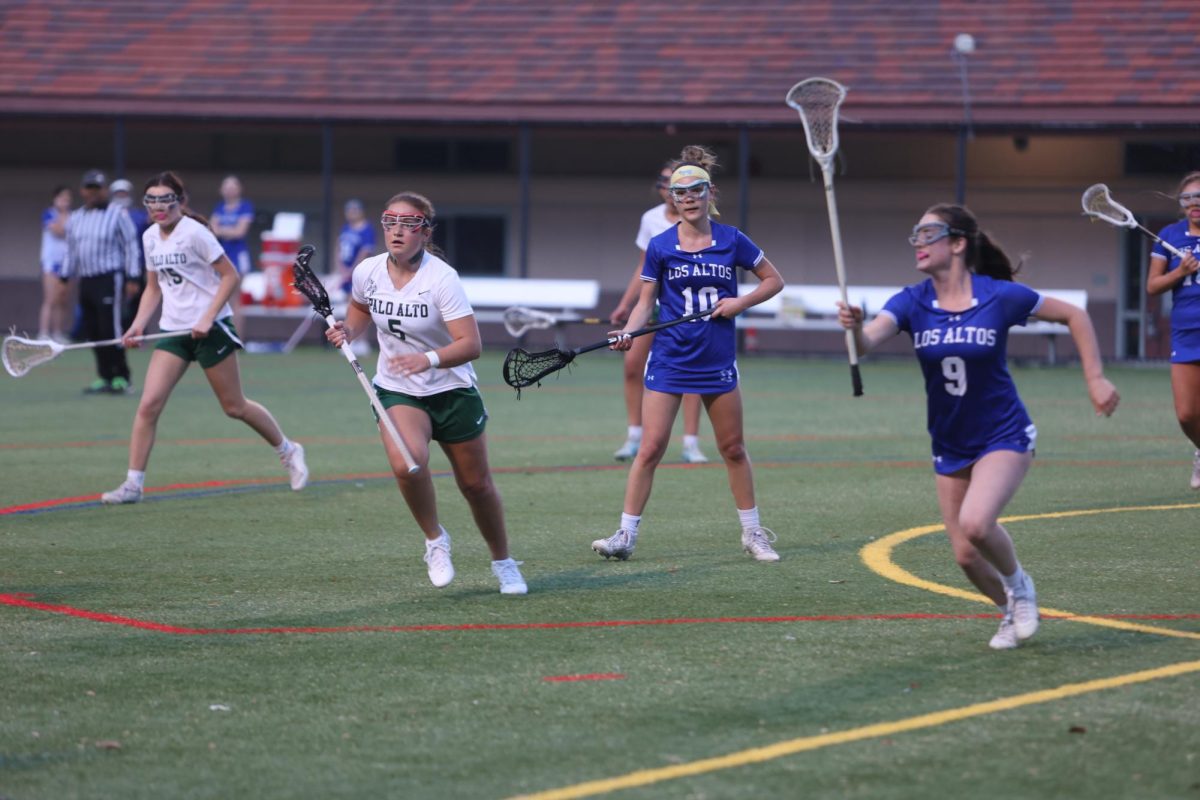An Athlete’s Advantage
February 18, 2016
In this introspective piece, The Viking explores the college recruitment process for many Paly student athletes and their paths to becoming college athletes. The experience of athletic recruitment can be very different for everyone, some may get into their school because of their sport, but then realize it’s not what they expected it to be and wind up leaving the team. Other athletes may have used their sport to put themselves out there and give them a shot of getting into schools they may not have through pure academics. And then there are the select few who have colleges actively recruiting them, giving that athlete the choice of where they want to go play their sport. Read on to see all of these cases demonstrated by current and former Paly athletes.
Erik Anderson (‘13) and Keri Gee (‘14) are two Paly student-athlete alumni who committed to their colleges for their respective sports after being recruited by the school. After getting into their schools and playing collegiately for their freshman years, they both decided to leave their respective teams. We look at their reasons for doing so and explore the paths of both student-athletes.
Erik Anderson
Anderson came across a couple different factors that resulted in him leaving his college football team. After winning the 2010 State Championship with the Vikings and playing varsity football for three seasons, Anderson decided to continue his football career at Claremont McKenna College (CMC). CMC is one of the top academic colleges in the nation, and despite questions about whether or not he’d have had a chance of getting into the college without football, Anderson raised a point that attributes his work ethic on the field to his success in the college admission process.
“In this day a nearly perfect GPA will not get you into a top institution,” Anderson said. “One must have an excellent transcript and a niche. [My niche] was football; all the hours of blood, sweat and tears paid off and I was fortunate enough to get the opportunity to play in college while receiving a great education.”
Anderson played his entire freshman season on the CMC football team before realizing that the experience wasn’t what he expected it to be. He faced many difficulties both on and off the field that he didn’t anticipate.
“It was difficult [adjusting to college academics], especially with the lack of support from the coaching staff,” Anderson said. “We didn’t have team study hall, tutors, or assistance with classes.”
This issue became one the the main contributing factors to Anderson leaving the team after his freshman year, but it wasn’t the whole reason. He faced an issue that is becoming more and more evident in football: concussions.
“It was a combination of factors that led to me hanging up the cleats,” Anderson said. “First was the C [concussion] word. Secondly, the lack of support from my coaches played a big part. With no academic support I felt lost, while other freshmen students who were not playing varsity sports had the time to navigate CMC’s challenging courses.”
Keri Gee
Gee had a very successful high school volleyball career. She was a member of both the 2010 and 2011 State Championship-winning teams and had a four year varsity career for the Vikings. As a result of her success, she was recruited to play volleyball at University of the Pacific (UOP) and choose the school heavily based on the prospect of playing Division I college volleyball.
“There were many reasons why I decided to go to UOP, but the main one was for volleyball,” Gee said.
After spending her freshman year at the school and playing on its volleyball team, Gee decided to leave the team and transfer to Southern Methodist University, foregoing her chance to continue playing collegiate volleyball. The prospect of playing a sport in college is one that seems enticing to the few who are given the opportunity, as it was for Gee, but she warns about the rigors that it actually comes with.
“Playing a sport in college is a full-time job, and while I loved it, I realized I had missed out on other things I wanted to enjoy during my time in college which is ultimately why I decided to transfer to a school that would allow those things to happen,” Gee said.
There can often be a misconception that the reason athletes leave teams in college is because of the coaches or players they’re surrounded by, but Gee refuted that based on her own personal experience.
“I didn’t quit my team because I didn’t like the program, players or coaches,” Gee said. “It was because you had to give 100% of yourself to the game physically and emotionally and near the end, I realized that I had burnt out.”
There are many student-athletes who get into their schools based on athletics, but not all of those athletes are being vigorously recruited and sought after. In this case, Justin Rittman (‘14) and Casey (whose name has been changed for anonymity) were put in positions where they had to display themselves to coaches and schools through direct contact due to a lack of colleges reaching out to them. Putting in effort to the networking side of the process on top of the already built athletic résumé opened up great opportunities to these individuals.
Justin Rittman
Rittman had played football since his early childhood, but he never thought that playing a sport he loved could get him into the University of California, Los Angeles (UCLA). Rittman had a successful high school football career: he was on the Vikings 2010 State Championship-winning team as a freshman and he became a vital member of the team his junior and seniors seasons, starting both ways for the Vikings at offensive tackle and defensive end. With a view towards the future, he began sending his football tapes to coaches around the country, but had one school in mind: UCLA.
“After I visited, I knew it [was] where I wanted to go,” Rittman said. “I loved the coaches for the team and the campus was great, too.”
It wasn’t just that simple, though. Rittman had to constantly remain in contact with the coaches to ensure that he ended up at the school he wanted. His hard work paid off when he was offered admission into UCLA as a preferred walk-on to the football team in March of his senior year.
The question is always raised of whether or not the athlete would’ve been able to get into their school without their sport, and Rittman acknowledged that, but tried to correct a common misconception about the process.
“I wouldn’t have had a real chance to go to UCLA without football and I think that bothers some people at the school,” Rittman said. “I think it bothers the students who don’t know how much time we actually put into our sport. The first day I got dropped off at UCLA we went straight to San Bernardino for our two week training camp before the season. It was miserable, but shows the level of work required to play sports at such a high level.”
Casey
Another Paly graduate, Casey (whose name has been changed for anonymity), had a very similar recruitment process to Rittman, but also reflects much more on the perception of athletes at their school. There can be a common assumption that people only start crew in high school in hopes that it will help them get into college, but as a member of a top collegiate rowing team, Casey is not among those people. However, Casey does acknowledge the benefit of their sport for the college admission process.
“When starting crew, college was never in mind and I had no idea I would be good enough to continue my sport to the collegiate level,” Casey said “As I got older and realized the possibilities of getting recruited, the college process definitely affected the way I viewed my sport, as there was now a huge and exciting goal ahead.”
Many athletes recruited to top academic schools for athletics don’t necessarily have the grades or scores that would’ve been required to get them into their school without their sport. This person realizes that perception is very true, but also believes that many different students bring different things to the community and they’re other people who didn’t get into the school for academics.
“There are definitely athletes who got into my school based on their athletic ability, but there are still standards to be met academically to be qualified to attend different universities,” Casey said. “As student-athletes we bring a lot to the community and we were admitted to this school just like every other student based on our talents. Each student brings something valuable to our student body, and athletes are no exception.”
Some athletes also had amazing academic accomplishments and great test scores to report to colleges. However, due to such a competitive application process, these athletes needed a boost to gain acceptance into their school. In this case, two former Paly athletes, Jack Anderson (‘14) and Misha Hindery (‘15), were both academically qualified for the colleges they attended, but sports helped give them an extra to boost to seal their acceptance into college.
Jack Anderson
In hopes of following in the footsteps of his two older brothers, who both played football at top academic schools, Anderson committed to play football at Dartmouth in the spring of his senior year. After talking to the football coaches at Dartmouth, Anderson and the coaches decided that he had a very good chance of getting in to Dartmouth based on his academic merit if he applied early action. In his initial application, the football coaches did not give him a special recommendation. Soon thereafter, Anderson learned he was deferred to the regular applicant pool, not rejected.
“After I was deferred, the football team offered me a spot for regular admission,” Anderson said. “I probably would not have been taken by just the college for regular admission, but had I not played, I think I would have been able to go to a school of slightly lesser caliber.”
While football gave his application a boost, Anderson was most definitely qualified to attend Dartmouth. Yet, he understood that for most competitive academic schools, your application needs to have something to set you apart from others.
“I absolutely thought that my sport would be beneficial to my college application process,”Anderson said, “I still thought about going somewhere to not play football, but in the end it was a huge help in getting me to the place where I wanted to be.”
As an athlete at Dartmouth, Anderson had a difficult time transitioning to the academic standards of the school, but the support from the football program helped him eventually succeed. Even with a harsh winter, Anderson fought through the mental grind and succeeded with his team.
“There are always thoughts of quitting when you’re walking to a lift at 6 am in New Hampshire winter, but none of them stick around too long,” Anderson said. “The team is too close knit, and the time commitment is very survivable.”
Misha Hindery
For some sports, high schools are unable to field a team due to lack of funding, facilities or other teams to compete against. As a result, fewer athletes participate in the sport, thus the pool of athletes is smaller for college coaches to choose from at the next level. A prime example of this kind of sport is crew.
Hindery began crew in eighth grade with the intent of playing the sport, not using it to get into college. However, as he progressed in the sport, he understood that through crew there were many college opportunities for him.
“As I got older I became more aware of how much [crew] would help,” Hindery said. “Rowing is different from lots of other sports in regards to recruiting. There are tons of kids who play football in high school, which enables colleges to be picky when it comes to recruiting; because high school rowing is still relatively small, there aren’t as many kids for colleges to choose from, and that makes us so desireable.”
Currently, Hindery is on the crew team at the University of Santa Clara. While Hindery believes he would have been accepted regardless of rowing, he believes there are other athletes at his school who were accepted based only on their athletic success.
“[Athletes admitted to schools based on athletic merit, not academic merit] are not a rare thing to see at a Division I school and most of the students know that,” Hindery said. “I wouldn’t say that ‘regular students’ care that much because they also got in. If anyone cares, it’s the people that got rejected.”
For many athletes who were admitted to schools with higher academic standards than the athlete had previously shown, the academic transition is very hard. However, most athletes find the transition hard regardless. For Hindery, the transition from high school athletics to college athletics was harder than he anticipated. However, Hindery did not quit after his freshman season because of a motto he lives by.
“If you aren’t thinking about quitting crew every time you row, you aren’t rowing hard enough,” Hindery said.
A select few athletes have the chance to commit to a college very early. In this case, we follow the path of two athletes, Jacey Pederson (‘16) and Andrew Liang (‘14), who committed early in their sophomore years. Instead of self-promoting themselves to a single college, these two athletes had the option to choose the school of their choice. As a result, they spent more time focusing on their athletic careers over their academics because they knew athletics gave them an unique opportunity to compete collegiately.
Jacey Pederson
In the case of Pederson, she experienced the luxury of colleges coming to her instead of constant self-promotion to colleges she wanted to attend. As a highly-sought-after recruit and member of the U.S. National Team, Pederson received an array of college offers ranging from Stanford University to University of North Carolina to UCLA. Like most athletes, Pederson did not begin playing her sport with the intent to receive a scholarship to a top university.
“I didn’t start soccer thinking it would earn me a scholarship, I just knew I really liked it and maybe if I worked hard enough I could play in college,” Pederson said.
After her hard work in soccer payed off, Pederson committed in February of her sophomore year to UCLA. According to UCLA admissions, in 2015, UCLA had an acceptance rate of 17.3%, and their average GPA for admitted incoming freshman was 4.39. For many Paly students not consumed with athletics, those standards are very hard to achieve.
“Without soccer I don’t think [UCLA] would have been a school within my reach, however that’s really hard to say because if I wasn’t playing soccer I may have been using all those hours and effort towards my academics and maybe UCLA would be a school within my reach,” Pederson said.
For many Paly athletes, it is very hard to maintain a balance of athletics and academics. To give an adequate amount of time to both, Pederson has spent many nights studying past the twilight hours.
While some may complain that Pederson did not have the numbers to get into UCLA, no one can say how well Pederson would have done in the classroom if she had more time to study.
Andrew Liang
Another Paly athlete who experienced the luxury of multiple schools expressing interest in him was swimmer Liang. As a participant in the Olympic trials, Liang drew interest from Harvard, Princeton, and Stanford, and took a recruiting trip to each school.
When he began swimming at the age of 10, swimming in college was not a goal of his. It was not until freshman year when he discovered that collegiate swimming was a real possibility. At the beginning of his senior year, Liang decided to commit to Stanford, a top swimming school in the nation.
“Academics were extremely important to me when choosing a school since life after athletics is a reality and having a school like Stanford could put me in a position to succeed,” Liang said.
Similar to many athletes, Liang spent an incredible amount of time swimming in high school, and an even larger amount of time in college. In Liang’s case, not only does he swim on a top swimming team in the nation, but he attends one of the most difficult academic schools in the nation.
“I didn’t think the adjustment [to Stanford] was too difficult,” Liang said. “I think that if you use the skills you’ve acquired in high school to juggle both academics and athletics then you’ll be fine. I also think that Paly sets you up pretty well to succeed in college.”
At a top Division I school, there are many cases where athletes get in based on athletics, however Liang holds a similar view as Pederson.
“I don’t think a person ever does not deserve to get into a school because they play a sport,” Liang said. “The person clearly devoted a great amount of time and energy in perfecting their talent, which just so happens to be athletics, and that’s essentially what colleges look for in applications- for you to stand out from a pool of applicants with your talents and achievements.”










